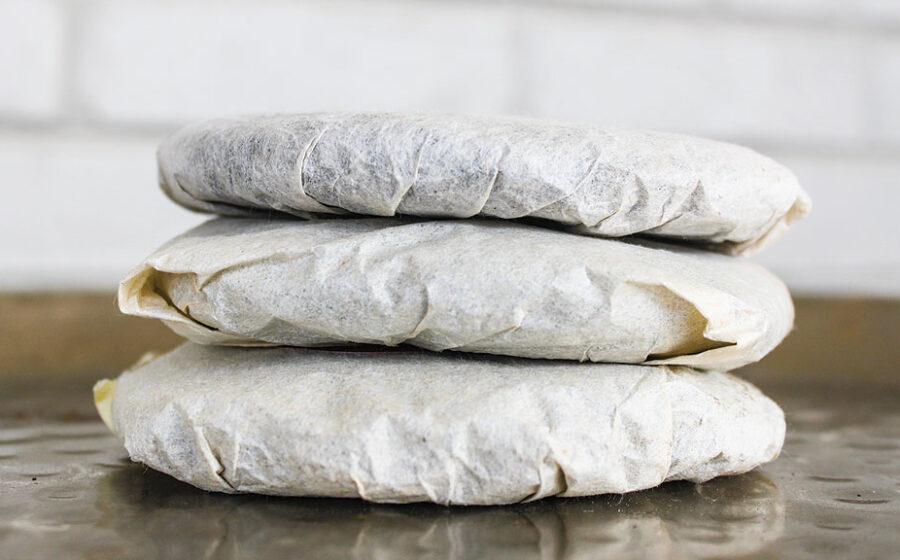[I]n southwestern China’s Yunnan province, there is a jaggedly crescent-shaped prefecture called Xishuangbanna that touches the borders of Myanmar and Laos. In this area on China’s frontier, there is a small, rural Dai village called Manzhou. The Dai are an ethnic group closely related to the Thai and Lao people. They are farmers, historically growing rice and water-intensive tropical crops like sugar cane, bamboo, and pineapples in the wide, green valleys along the banks of the Lancang River (better known as the Mekong, its name in the Indochinese Peninsula). The Dai also are the original pu-erh tea farmers, having planted, cultivated, and processed pu-erh tea for almost 2,000 years in the famous tea mountains of the region.
The Dai are water people, too. They rely on the rivers for all aspects of life, from transportation to food, and culminate their New Year with their biggest celebration, the Water Splashing Festival. During this time, revelers run around the streets dousing each other with water buckets, balloons, hoses, and guns in a merry and wild religious celebration of renewal and blessing.
The village of Manzhou is not well known or frequently visited by tea travelers. Its residents are not known for making or selling the region’s famous pu-erh tea. Rather, they are masters of a related craft—paper making. Specifically, the making of the strong and supple paper that is used to wrap bingcha, cakes of pu-erh tea. Manzhou is the only papermaking village in the region that serves the pu-erh masters.
One could argue that their paper, with its specific porosity, is key to the proper aging of bingcha. A living product, pu-erh tea must be able to breathe and release gases to age without rotting or molding. Only a natural, breathable material will work. Conversely, pu-erh tea must be protected from the elements for years, even decades, so that it will not deteriorate. The paper must also be strong enough to withstand years of storage without breaking down.
In China, the craft of papermaking has been passed through generations since 100 CE, maybe even earlier. One of China’s great ancient inventions, paper was historically used for scripting prayers, making umbrellas, recording history, and even for clothing. Traditionally, women are the artisans. The men assist by pounding the pulp and making the bamboo frames for drying the paper. It is the women who possess the skill to delicately and uniformly place the pulp, suspended in water, into the frames for drying, making the perfect wrapping for pu-erh.
[T]he process from wood to paper starts with the inner bark, or phloem, of the paper mulberry tree. The paper mulberry used to grow wild in Yunnan, but is now is imported by the ton from Laos as it becomes increasingly rare in the forests of China.

The paper mulberry’s phloem is uniquely strong and lightweight, and has been used across Asia for papermaking for millennia. One ton of bark, purchased for about $900, is needed to make 100,000 pages. First, the bark soaks for at least three hours in a giant kettle of water and ash, until it begins to soften. A wood fire is then lit under the kettle and, once soft, the men, who work the paper at this stage, pound the bark into a pulp, yielding a glutinous mass of individual fibers suspended in the water. The men then use a wooden mallet to methodically pound the pulp until the fibers separate. There are several paper kettles throughout Manzhou, and it’s hard to tell if the smoke scenting the air is coming from a neighbor’s whiskey still or a kettle.

Once the bark has been turned into a pulp, it’s transferred into another large stone vat. The women add water slowly until the mixture reaches the desired consistency.

The pulp mixture is then set into a frame; this is a delicate process requiring talented hands to evenly distribute the gelatinous mass over the frame before it is dried. The pulp should cover the framed screen with a uniform thickness so that the paper will be smooth and there will not be any holes that leave the tea exposed.

Once set and formed, the screens are lifted and placed upright and at an angle in the sun until the paper is dry. On rainy days, the screens are placed under the cover of a porch to keep the paper intact. The finished sheets, measuring forty-six by ninety centimeters, are satiny, natural pieces of art, the result of a day’s work.

Soft, non-toxic, beautiful, and sturdy, this paper is a natural fit for protecting the world’s most valuable tea.

Manzhou’s papermakers sell this paper for forty-eight to eighty cents a sheet, depending on quality and thickness. This amounts to $6,000 annually for the village.
—Sarah Scarborough is the founder of Firepot Nomadic Teas and author of Nomadic Tea Party.









